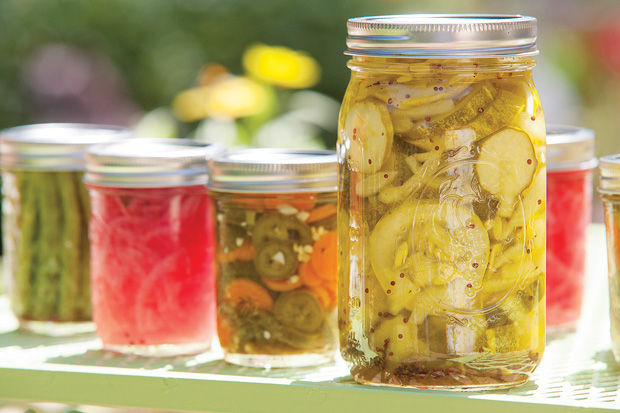Pick from a peck of pickle varieties
Published August 21, 2014
Are you reeling from a surplus of jalapeño peppers in your garden? We are. Or perhaps you’ve been to the market and seen the huge baskets of appetizing and relatively inexpensive zucchini. Or maybe you’ve been craving a bowl of pickled cauliflower to enjoy with a glass of white wine.
I have a solution: Start pickling. It’s quick and easy, and the flavor and quality will trump anything you can buy in a jar. Not only are pickled foods a great nosh, but their addition to something as ordinary as a turkey sandwich, a pan of scrambled eggs, or even a grilled steak or fillet of fish will make those items extraordinary. There’s no limit to the possibilities.
When most of us think of pickles, we think of pickled cucumbers. Guess what? Just about anything can be pickled, from beets to figs to garlic to plums to herring. And if stored properly in your refrigerator, you can enjoy these pickles for at least a month. Pack them in your picnic basket, serve them with cocktails or add them as an accompaniment to your main course.
Pickling at home means that you pick the food and you control the flavors. By simply substituting different spices and seeds, you can customize your pickles. What’s not to like? And, as an added bonus (explained below) the results are healthy.
The basic procedure for pickling is relatively simple: Immerse fresh fruits or vegetables into a brine of vinegar, salt and spices that has been briefly boiled. Meanwhile, pack sterile jars with your favorite raw fruits or vegetables, add enough of the hot brine to cover them and screw the lids onto the jars. When the jars reach room temperature, place them in your refrigerator.
Voila! Your pickles will be ready to eat after just one hour. For fuller flavored- pickles, give them a few days. The flavor peaks in about three days. Doesn’t get much easier than that, right? Well there’s another way to pickle: fermenting.
If you’ve ever selected a pickle from a pickle barrel, chances are that the pickle was fermented. The process for fermenting is just as easy as regular pickling. The biggest difference is that food ferments in jars at room temperature after being submerged in a cooled salt-brine. The acidic and saline environment of the brine, working in harmony with the bacteria that live on the cleaned skins of your fruit and vegetables, produces lactic acid. It is the lactic acid that acts as a natural preservative.
The fermenting process takes three to five days, and you don’t have to do a thing during that time. These pickles are really good, and they’re really good for you. While they won’t cure everything that ails you, the bacteria have proven health benefits.
In short, pickling is a simple and mouthwatering way to transform and preserve the bounty of summer. You create great foods with great flavors, and it’s fun to do, and even more fun to do together as a family.
Pickles of all types – cucumbers, zucchinis, green beans, okra, pears, apples – are delicious and good for you. And when you open your refrigerator and see all of those colorful jars of ready-to-eat goodness, you’ll be so glad you gave it try.
Margi Lenga Kahn is the mother of five and grandmother of five. A cooking instructor at the Kitchen Conservatory, she is working on a project to preserve the stories and recipes of heritage cooks. She welcomes your comments and suggestions at [email protected].















